Critical Review of the HSR Food Policy System
VerifiedAdded on 2022/11/15
|14
|4093
|122
AI Summary
This critical review analyzes the effectiveness of the HSR food policy system, specifically the Front of Package Nutritional Labelling (FOPNL) as a policy action. It discusses the strengths and weaknesses of the system, and the competing worldviews involved in its formulation.
Contribute Materials
Your contribution can guide someone’s learning journey. Share your
documents today.
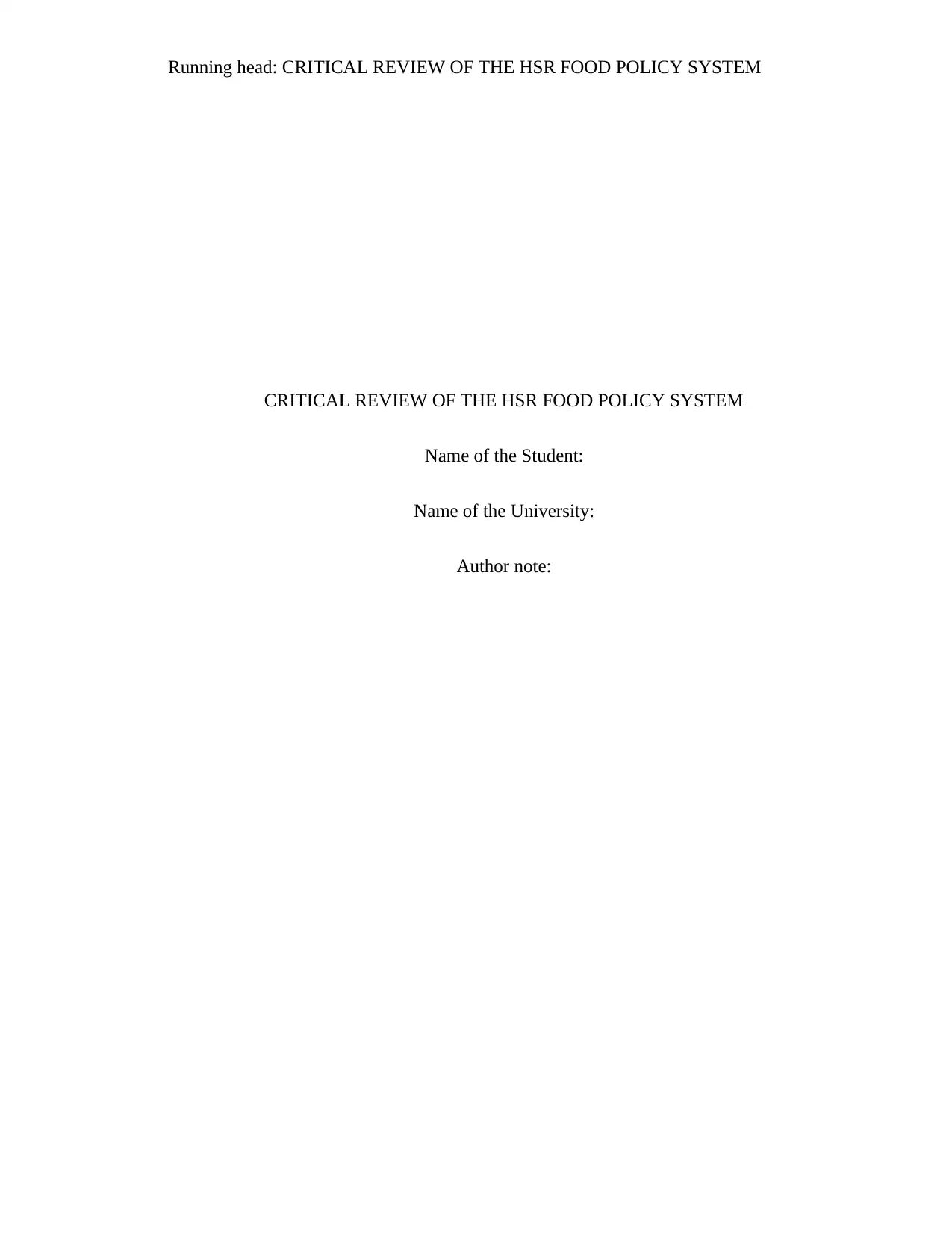
Running head: CRITICAL REVIEW OF THE HSR FOOD POLICY SYSTEM
CRITICAL REVIEW OF THE HSR FOOD POLICY SYSTEM
Name of the Student:
Name of the University:
Author note:
CRITICAL REVIEW OF THE HSR FOOD POLICY SYSTEM
Name of the Student:
Name of the University:
Author note:
Secure Best Marks with AI Grader
Need help grading? Try our AI Grader for instant feedback on your assignments.
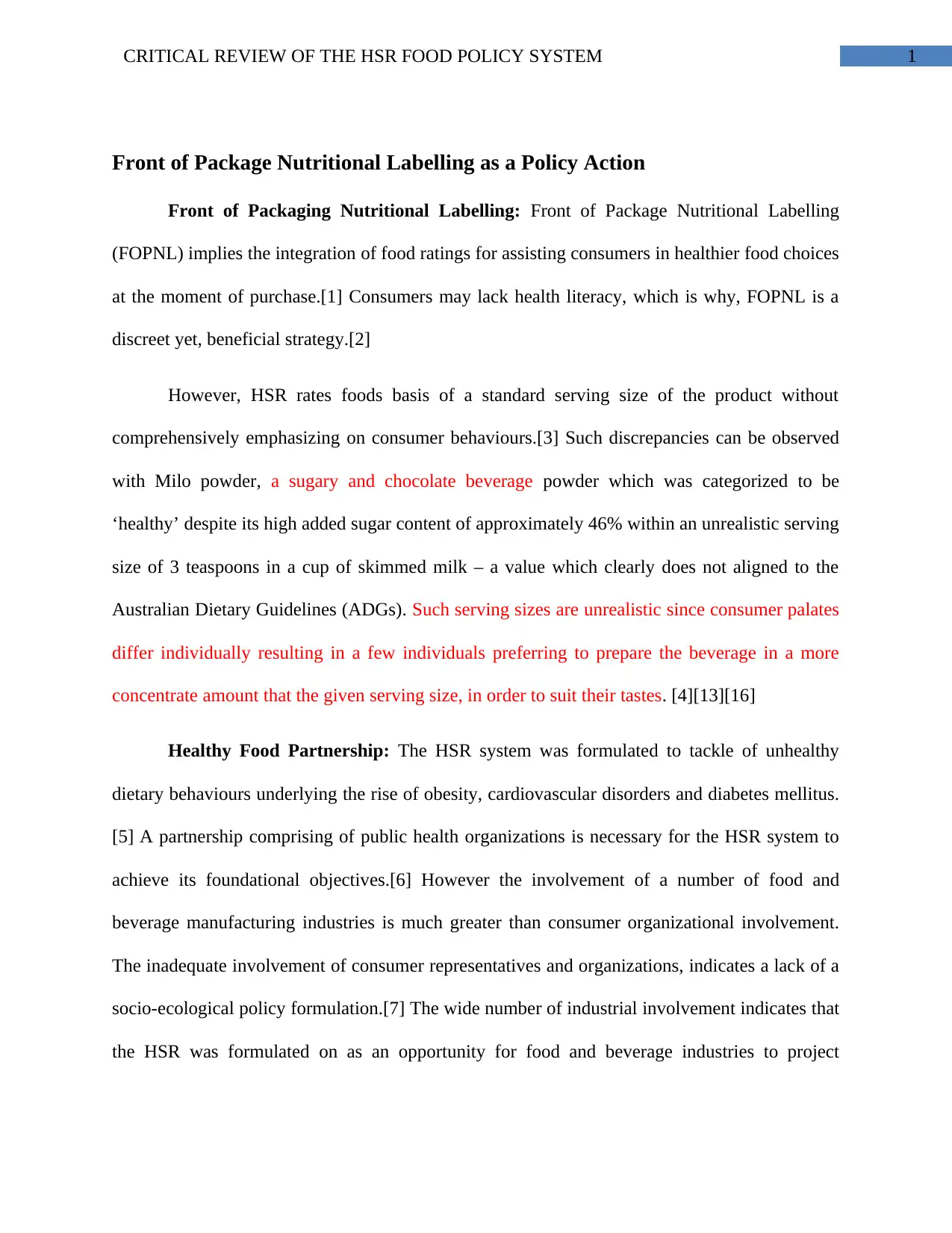
1CRITICAL REVIEW OF THE HSR FOOD POLICY SYSTEM
Front of Package Nutritional Labelling as a Policy Action
Front of Packaging Nutritional Labelling: Front of Package Nutritional Labelling
(FOPNL) implies the integration of food ratings for assisting consumers in healthier food choices
at the moment of purchase.[1] Consumers may lack health literacy, which is why, FOPNL is a
discreet yet, beneficial strategy.[2]
However, HSR rates foods basis of a standard serving size of the product without
comprehensively emphasizing on consumer behaviours.[3] Such discrepancies can be observed
with Milo powder, a sugary and chocolate beverage powder which was categorized to be
‘healthy’ despite its high added sugar content of approximately 46% within an unrealistic serving
size of 3 teaspoons in a cup of skimmed milk – a value which clearly does not aligned to the
Australian Dietary Guidelines (ADGs). Such serving sizes are unrealistic since consumer palates
differ individually resulting in a few individuals preferring to prepare the beverage in a more
concentrate amount that the given serving size, in order to suit their tastes. [4][13][16]
Healthy Food Partnership: The HSR system was formulated to tackle of unhealthy
dietary behaviours underlying the rise of obesity, cardiovascular disorders and diabetes mellitus.
[5] A partnership comprising of public health organizations is necessary for the HSR system to
achieve its foundational objectives.[6] However the involvement of a number of food and
beverage manufacturing industries is much greater than consumer organizational involvement.
The inadequate involvement of consumer representatives and organizations, indicates a lack of a
socio-ecological policy formulation.[7] The wide number of industrial involvement indicates that
the HSR was formulated on as an opportunity for food and beverage industries to project
Front of Package Nutritional Labelling as a Policy Action
Front of Packaging Nutritional Labelling: Front of Package Nutritional Labelling
(FOPNL) implies the integration of food ratings for assisting consumers in healthier food choices
at the moment of purchase.[1] Consumers may lack health literacy, which is why, FOPNL is a
discreet yet, beneficial strategy.[2]
However, HSR rates foods basis of a standard serving size of the product without
comprehensively emphasizing on consumer behaviours.[3] Such discrepancies can be observed
with Milo powder, a sugary and chocolate beverage powder which was categorized to be
‘healthy’ despite its high added sugar content of approximately 46% within an unrealistic serving
size of 3 teaspoons in a cup of skimmed milk – a value which clearly does not aligned to the
Australian Dietary Guidelines (ADGs). Such serving sizes are unrealistic since consumer palates
differ individually resulting in a few individuals preferring to prepare the beverage in a more
concentrate amount that the given serving size, in order to suit their tastes. [4][13][16]
Healthy Food Partnership: The HSR system was formulated to tackle of unhealthy
dietary behaviours underlying the rise of obesity, cardiovascular disorders and diabetes mellitus.
[5] A partnership comprising of public health organizations is necessary for the HSR system to
achieve its foundational objectives.[6] However the involvement of a number of food and
beverage manufacturing industries is much greater than consumer organizational involvement.
The inadequate involvement of consumer representatives and organizations, indicates a lack of a
socio-ecological policy formulation.[7] The wide number of industrial involvement indicates that
the HSR was formulated on as an opportunity for food and beverage industries to project
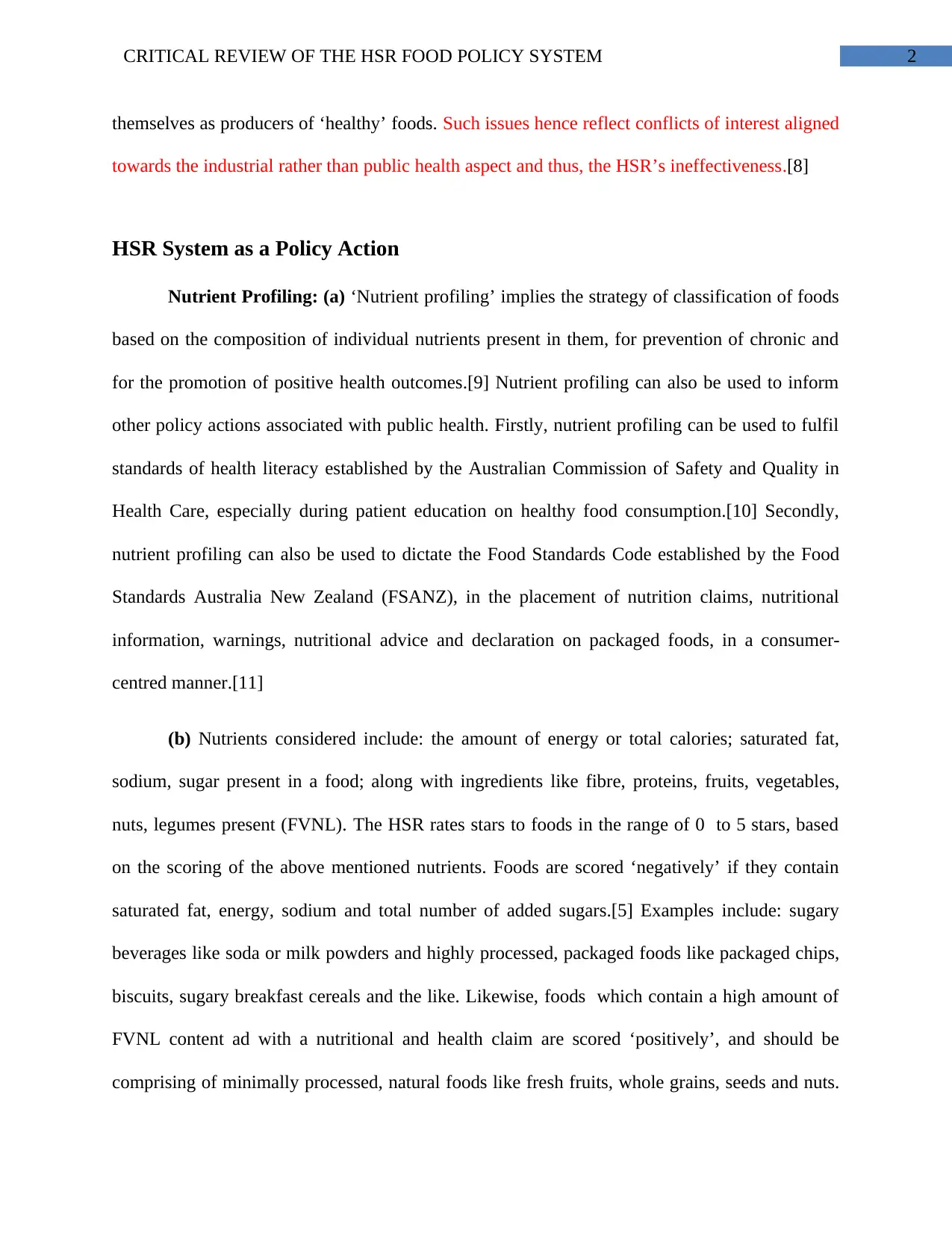
2CRITICAL REVIEW OF THE HSR FOOD POLICY SYSTEM
themselves as producers of ‘healthy’ foods. Such issues hence reflect conflicts of interest aligned
towards the industrial rather than public health aspect and thus, the HSR’s ineffectiveness.[8]
HSR System as a Policy Action
Nutrient Profiling: (a) ‘Nutrient profiling’ implies the strategy of classification of foods
based on the composition of individual nutrients present in them, for prevention of chronic and
for the promotion of positive health outcomes.[9] Nutrient profiling can also be used to inform
other policy actions associated with public health. Firstly, nutrient profiling can be used to fulfil
standards of health literacy established by the Australian Commission of Safety and Quality in
Health Care, especially during patient education on healthy food consumption.[10] Secondly,
nutrient profiling can also be used to dictate the Food Standards Code established by the Food
Standards Australia New Zealand (FSANZ), in the placement of nutrition claims, nutritional
information, warnings, nutritional advice and declaration on packaged foods, in a consumer-
centred manner.[11]
(b) Nutrients considered include: the amount of energy or total calories; saturated fat,
sodium, sugar present in a food; along with ingredients like fibre, proteins, fruits, vegetables,
nuts, legumes present (FVNL). The HSR rates stars to foods in the range of 0 to 5 stars, based
on the scoring of the above mentioned nutrients. Foods are scored ‘negatively’ if they contain
saturated fat, energy, sodium and total number of added sugars.[5] Examples include: sugary
beverages like soda or milk powders and highly processed, packaged foods like packaged chips,
biscuits, sugary breakfast cereals and the like. Likewise, foods which contain a high amount of
FVNL content ad with a nutritional and health claim are scored ‘positively’, and should be
comprising of minimally processed, natural foods like fresh fruits, whole grains, seeds and nuts.
themselves as producers of ‘healthy’ foods. Such issues hence reflect conflicts of interest aligned
towards the industrial rather than public health aspect and thus, the HSR’s ineffectiveness.[8]
HSR System as a Policy Action
Nutrient Profiling: (a) ‘Nutrient profiling’ implies the strategy of classification of foods
based on the composition of individual nutrients present in them, for prevention of chronic and
for the promotion of positive health outcomes.[9] Nutrient profiling can also be used to inform
other policy actions associated with public health. Firstly, nutrient profiling can be used to fulfil
standards of health literacy established by the Australian Commission of Safety and Quality in
Health Care, especially during patient education on healthy food consumption.[10] Secondly,
nutrient profiling can also be used to dictate the Food Standards Code established by the Food
Standards Australia New Zealand (FSANZ), in the placement of nutrition claims, nutritional
information, warnings, nutritional advice and declaration on packaged foods, in a consumer-
centred manner.[11]
(b) Nutrients considered include: the amount of energy or total calories; saturated fat,
sodium, sugar present in a food; along with ingredients like fibre, proteins, fruits, vegetables,
nuts, legumes present (FVNL). The HSR rates stars to foods in the range of 0 to 5 stars, based
on the scoring of the above mentioned nutrients. Foods are scored ‘negatively’ if they contain
saturated fat, energy, sodium and total number of added sugars.[5] Examples include: sugary
beverages like soda or milk powders and highly processed, packaged foods like packaged chips,
biscuits, sugary breakfast cereals and the like. Likewise, foods which contain a high amount of
FVNL content ad with a nutritional and health claim are scored ‘positively’, and should be
comprising of minimally processed, natural foods like fresh fruits, whole grains, seeds and nuts.
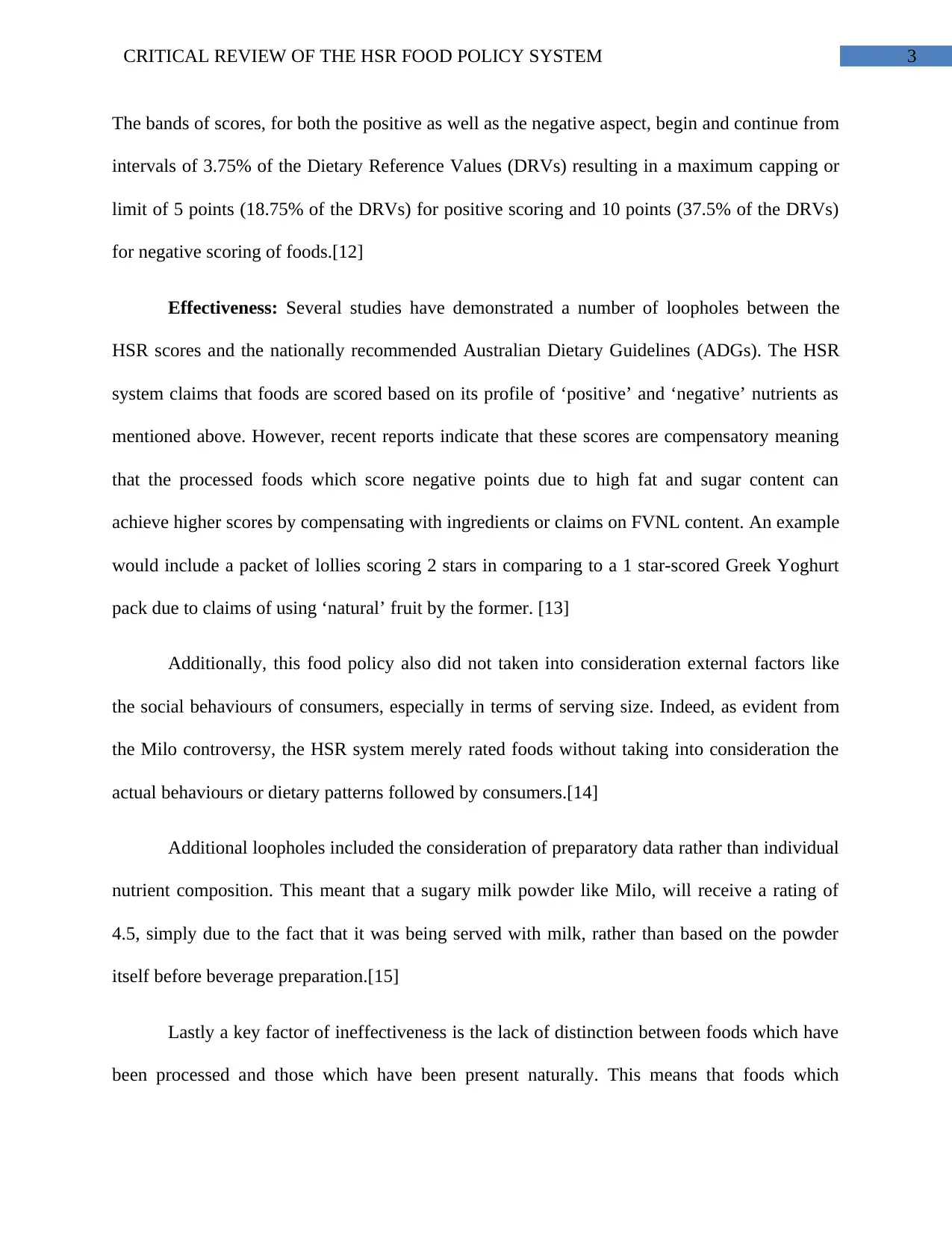
3CRITICAL REVIEW OF THE HSR FOOD POLICY SYSTEM
The bands of scores, for both the positive as well as the negative aspect, begin and continue from
intervals of 3.75% of the Dietary Reference Values (DRVs) resulting in a maximum capping or
limit of 5 points (18.75% of the DRVs) for positive scoring and 10 points (37.5% of the DRVs)
for negative scoring of foods.[12]
Effectiveness: Several studies have demonstrated a number of loopholes between the
HSR scores and the nationally recommended Australian Dietary Guidelines (ADGs). The HSR
system claims that foods are scored based on its profile of ‘positive’ and ‘negative’ nutrients as
mentioned above. However, recent reports indicate that these scores are compensatory meaning
that the processed foods which score negative points due to high fat and sugar content can
achieve higher scores by compensating with ingredients or claims on FVNL content. An example
would include a packet of lollies scoring 2 stars in comparing to a 1 star-scored Greek Yoghurt
pack due to claims of using ‘natural’ fruit by the former. [13]
Additionally, this food policy also did not taken into consideration external factors like
the social behaviours of consumers, especially in terms of serving size. Indeed, as evident from
the Milo controversy, the HSR system merely rated foods without taking into consideration the
actual behaviours or dietary patterns followed by consumers.[14]
Additional loopholes included the consideration of preparatory data rather than individual
nutrient composition. This meant that a sugary milk powder like Milo, will receive a rating of
4.5, simply due to the fact that it was being served with milk, rather than based on the powder
itself before beverage preparation.[15]
Lastly a key factor of ineffectiveness is the lack of distinction between foods which have
been processed and those which have been present naturally. This means that foods which
The bands of scores, for both the positive as well as the negative aspect, begin and continue from
intervals of 3.75% of the Dietary Reference Values (DRVs) resulting in a maximum capping or
limit of 5 points (18.75% of the DRVs) for positive scoring and 10 points (37.5% of the DRVs)
for negative scoring of foods.[12]
Effectiveness: Several studies have demonstrated a number of loopholes between the
HSR scores and the nationally recommended Australian Dietary Guidelines (ADGs). The HSR
system claims that foods are scored based on its profile of ‘positive’ and ‘negative’ nutrients as
mentioned above. However, recent reports indicate that these scores are compensatory meaning
that the processed foods which score negative points due to high fat and sugar content can
achieve higher scores by compensating with ingredients or claims on FVNL content. An example
would include a packet of lollies scoring 2 stars in comparing to a 1 star-scored Greek Yoghurt
pack due to claims of using ‘natural’ fruit by the former. [13]
Additionally, this food policy also did not taken into consideration external factors like
the social behaviours of consumers, especially in terms of serving size. Indeed, as evident from
the Milo controversy, the HSR system merely rated foods without taking into consideration the
actual behaviours or dietary patterns followed by consumers.[14]
Additional loopholes included the consideration of preparatory data rather than individual
nutrient composition. This meant that a sugary milk powder like Milo, will receive a rating of
4.5, simply due to the fact that it was being served with milk, rather than based on the powder
itself before beverage preparation.[15]
Lastly a key factor of ineffectiveness is the lack of distinction between foods which have
been processed and those which have been present naturally. This means that foods which
Secure Best Marks with AI Grader
Need help grading? Try our AI Grader for instant feedback on your assignments.
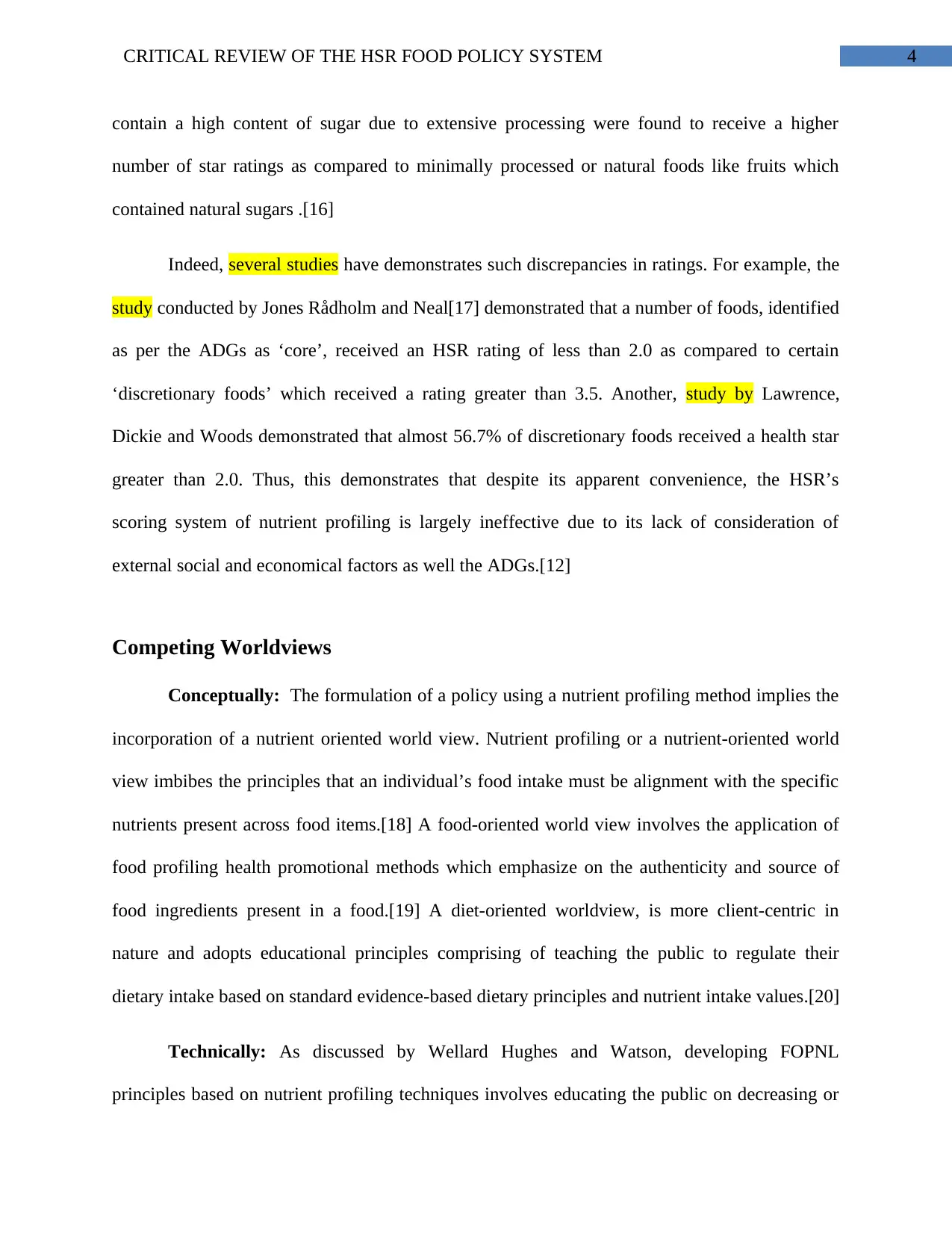
4CRITICAL REVIEW OF THE HSR FOOD POLICY SYSTEM
contain a high content of sugar due to extensive processing were found to receive a higher
number of star ratings as compared to minimally processed or natural foods like fruits which
contained natural sugars .[16]
Indeed, several studies have demonstrates such discrepancies in ratings. For example, the
study conducted by Jones Rådholm and Neal[17] demonstrated that a number of foods, identified
as per the ADGs as ‘core’, received an HSR rating of less than 2.0 as compared to certain
‘discretionary foods’ which received a rating greater than 3.5. Another, study by Lawrence,
Dickie and Woods demonstrated that almost 56.7% of discretionary foods received a health star
greater than 2.0. Thus, this demonstrates that despite its apparent convenience, the HSR’s
scoring system of nutrient profiling is largely ineffective due to its lack of consideration of
external social and economical factors as well the ADGs.[12]
Competing Worldviews
Conceptually: The formulation of a policy using a nutrient profiling method implies the
incorporation of a nutrient oriented world view. Nutrient profiling or a nutrient-oriented world
view imbibes the principles that an individual’s food intake must be alignment with the specific
nutrients present across food items.[18] A food-oriented world view involves the application of
food profiling health promotional methods which emphasize on the authenticity and source of
food ingredients present in a food.[19] A diet-oriented worldview, is more client-centric in
nature and adopts educational principles comprising of teaching the public to regulate their
dietary intake based on standard evidence-based dietary principles and nutrient intake values.[20]
Technically: As discussed by Wellard Hughes and Watson, developing FOPNL
principles based on nutrient profiling techniques involves educating the public on decreasing or
contain a high content of sugar due to extensive processing were found to receive a higher
number of star ratings as compared to minimally processed or natural foods like fruits which
contained natural sugars .[16]
Indeed, several studies have demonstrates such discrepancies in ratings. For example, the
study conducted by Jones Rådholm and Neal[17] demonstrated that a number of foods, identified
as per the ADGs as ‘core’, received an HSR rating of less than 2.0 as compared to certain
‘discretionary foods’ which received a rating greater than 3.5. Another, study by Lawrence,
Dickie and Woods demonstrated that almost 56.7% of discretionary foods received a health star
greater than 2.0. Thus, this demonstrates that despite its apparent convenience, the HSR’s
scoring system of nutrient profiling is largely ineffective due to its lack of consideration of
external social and economical factors as well the ADGs.[12]
Competing Worldviews
Conceptually: The formulation of a policy using a nutrient profiling method implies the
incorporation of a nutrient oriented world view. Nutrient profiling or a nutrient-oriented world
view imbibes the principles that an individual’s food intake must be alignment with the specific
nutrients present across food items.[18] A food-oriented world view involves the application of
food profiling health promotional methods which emphasize on the authenticity and source of
food ingredients present in a food.[19] A diet-oriented worldview, is more client-centric in
nature and adopts educational principles comprising of teaching the public to regulate their
dietary intake based on standard evidence-based dietary principles and nutrient intake values.[20]
Technically: As discussed by Wellard Hughes and Watson, developing FOPNL
principles based on nutrient profiling techniques involves educating the public on decreasing or
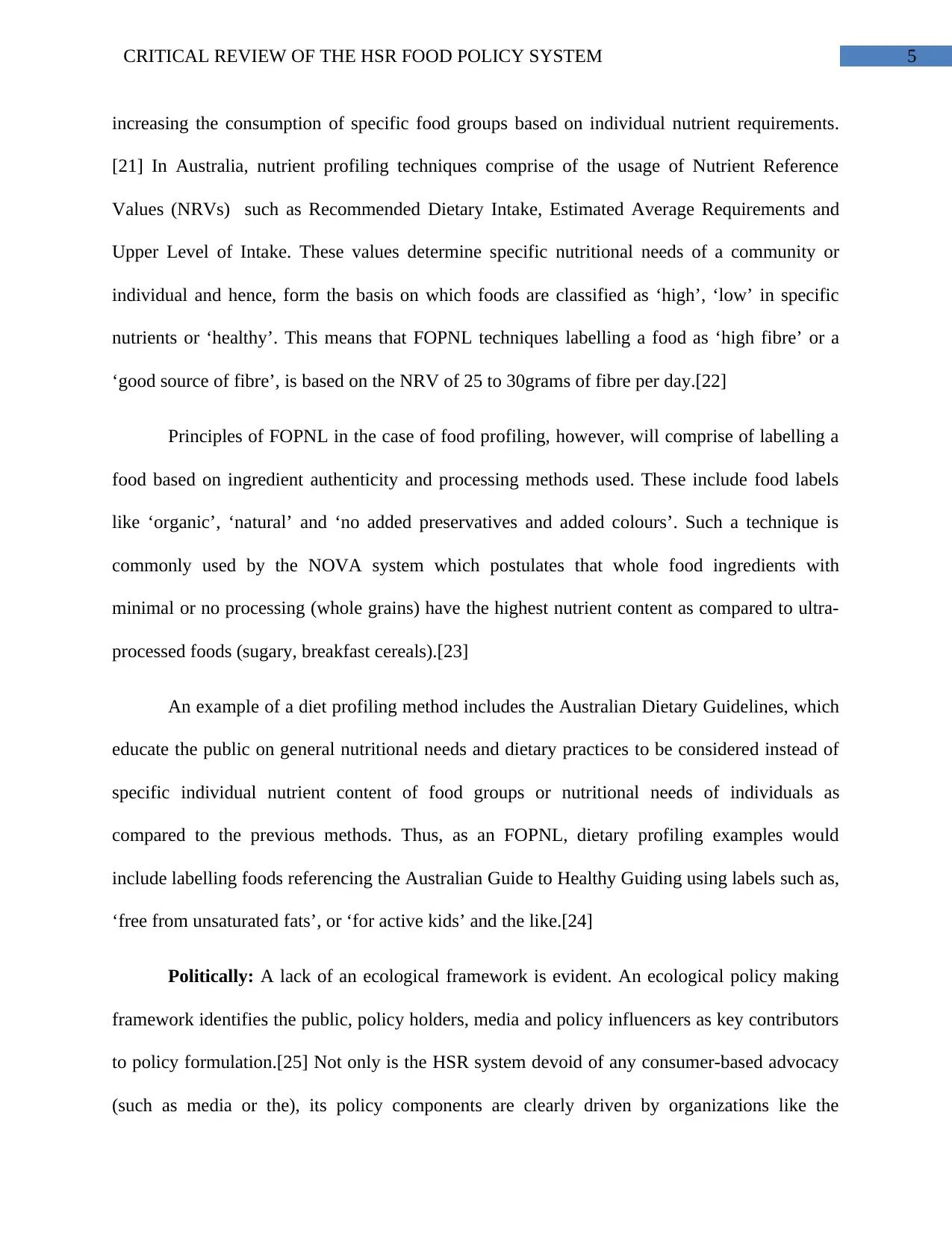
5CRITICAL REVIEW OF THE HSR FOOD POLICY SYSTEM
increasing the consumption of specific food groups based on individual nutrient requirements.
[21] In Australia, nutrient profiling techniques comprise of the usage of Nutrient Reference
Values (NRVs) such as Recommended Dietary Intake, Estimated Average Requirements and
Upper Level of Intake. These values determine specific nutritional needs of a community or
individual and hence, form the basis on which foods are classified as ‘high’, ‘low’ in specific
nutrients or ‘healthy’. This means that FOPNL techniques labelling a food as ‘high fibre’ or a
‘good source of fibre’, is based on the NRV of 25 to 30grams of fibre per day.[22]
Principles of FOPNL in the case of food profiling, however, will comprise of labelling a
food based on ingredient authenticity and processing methods used. These include food labels
like ‘organic’, ‘natural’ and ‘no added preservatives and added colours’. Such a technique is
commonly used by the NOVA system which postulates that whole food ingredients with
minimal or no processing (whole grains) have the highest nutrient content as compared to ultra-
processed foods (sugary, breakfast cereals).[23]
An example of a diet profiling method includes the Australian Dietary Guidelines, which
educate the public on general nutritional needs and dietary practices to be considered instead of
specific individual nutrient content of food groups or nutritional needs of individuals as
compared to the previous methods. Thus, as an FOPNL, dietary profiling examples would
include labelling foods referencing the Australian Guide to Healthy Guiding using labels such as,
‘free from unsaturated fats’, or ‘for active kids’ and the like.[24]
Politically: A lack of an ecological framework is evident. An ecological policy making
framework identifies the public, policy holders, media and policy influencers as key contributors
to policy formulation.[25] Not only is the HSR system devoid of any consumer-based advocacy
(such as media or the), its policy components are clearly driven by organizations like the
increasing the consumption of specific food groups based on individual nutrient requirements.
[21] In Australia, nutrient profiling techniques comprise of the usage of Nutrient Reference
Values (NRVs) such as Recommended Dietary Intake, Estimated Average Requirements and
Upper Level of Intake. These values determine specific nutritional needs of a community or
individual and hence, form the basis on which foods are classified as ‘high’, ‘low’ in specific
nutrients or ‘healthy’. This means that FOPNL techniques labelling a food as ‘high fibre’ or a
‘good source of fibre’, is based on the NRV of 25 to 30grams of fibre per day.[22]
Principles of FOPNL in the case of food profiling, however, will comprise of labelling a
food based on ingredient authenticity and processing methods used. These include food labels
like ‘organic’, ‘natural’ and ‘no added preservatives and added colours’. Such a technique is
commonly used by the NOVA system which postulates that whole food ingredients with
minimal or no processing (whole grains) have the highest nutrient content as compared to ultra-
processed foods (sugary, breakfast cereals).[23]
An example of a diet profiling method includes the Australian Dietary Guidelines, which
educate the public on general nutritional needs and dietary practices to be considered instead of
specific individual nutrient content of food groups or nutritional needs of individuals as
compared to the previous methods. Thus, as an FOPNL, dietary profiling examples would
include labelling foods referencing the Australian Guide to Healthy Guiding using labels such as,
‘free from unsaturated fats’, or ‘for active kids’ and the like.[24]
Politically: A lack of an ecological framework is evident. An ecological policy making
framework identifies the public, policy holders, media and policy influencers as key contributors
to policy formulation.[25] Not only is the HSR system devoid of any consumer-based advocacy
(such as media or the), its policy components are clearly driven by organizations like the
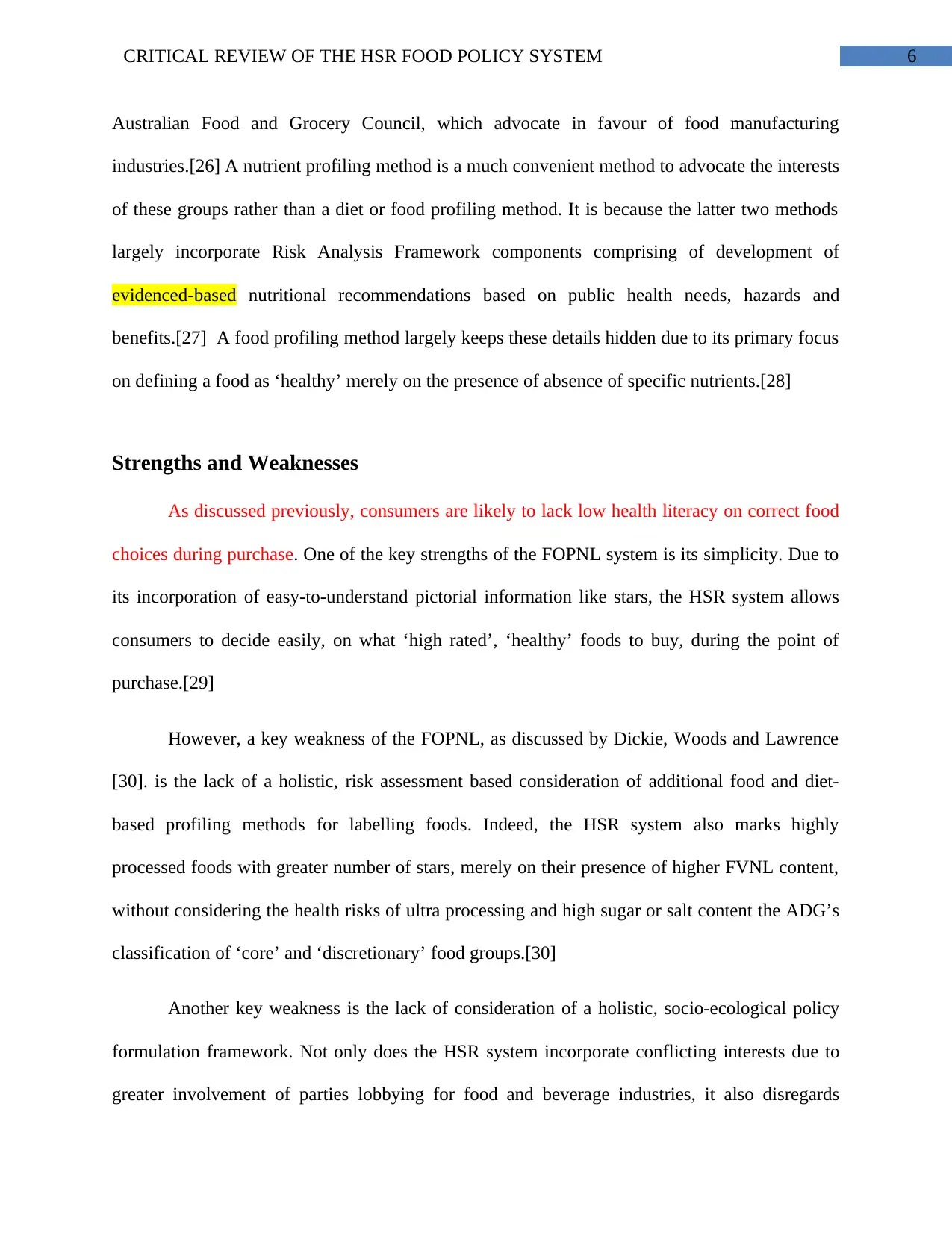
6CRITICAL REVIEW OF THE HSR FOOD POLICY SYSTEM
Australian Food and Grocery Council, which advocate in favour of food manufacturing
industries.[26] A nutrient profiling method is a much convenient method to advocate the interests
of these groups rather than a diet or food profiling method. It is because the latter two methods
largely incorporate Risk Analysis Framework components comprising of development of
evidenced-based nutritional recommendations based on public health needs, hazards and
benefits.[27] A food profiling method largely keeps these details hidden due to its primary focus
on defining a food as ‘healthy’ merely on the presence of absence of specific nutrients.[28]
Strengths and Weaknesses
As discussed previously, consumers are likely to lack low health literacy on correct food
choices during purchase. One of the key strengths of the FOPNL system is its simplicity. Due to
its incorporation of easy-to-understand pictorial information like stars, the HSR system allows
consumers to decide easily, on what ‘high rated’, ‘healthy’ foods to buy, during the point of
purchase.[29]
However, a key weakness of the FOPNL, as discussed by Dickie, Woods and Lawrence
[30]. is the lack of a holistic, risk assessment based consideration of additional food and diet-
based profiling methods for labelling foods. Indeed, the HSR system also marks highly
processed foods with greater number of stars, merely on their presence of higher FVNL content,
without considering the health risks of ultra processing and high sugar or salt content the ADG’s
classification of ‘core’ and ‘discretionary’ food groups.[30]
Another key weakness is the lack of consideration of a holistic, socio-ecological policy
formulation framework. Not only does the HSR system incorporate conflicting interests due to
greater involvement of parties lobbying for food and beverage industries, it also disregards
Australian Food and Grocery Council, which advocate in favour of food manufacturing
industries.[26] A nutrient profiling method is a much convenient method to advocate the interests
of these groups rather than a diet or food profiling method. It is because the latter two methods
largely incorporate Risk Analysis Framework components comprising of development of
evidenced-based nutritional recommendations based on public health needs, hazards and
benefits.[27] A food profiling method largely keeps these details hidden due to its primary focus
on defining a food as ‘healthy’ merely on the presence of absence of specific nutrients.[28]
Strengths and Weaknesses
As discussed previously, consumers are likely to lack low health literacy on correct food
choices during purchase. One of the key strengths of the FOPNL system is its simplicity. Due to
its incorporation of easy-to-understand pictorial information like stars, the HSR system allows
consumers to decide easily, on what ‘high rated’, ‘healthy’ foods to buy, during the point of
purchase.[29]
However, a key weakness of the FOPNL, as discussed by Dickie, Woods and Lawrence
[30]. is the lack of a holistic, risk assessment based consideration of additional food and diet-
based profiling methods for labelling foods. Indeed, the HSR system also marks highly
processed foods with greater number of stars, merely on their presence of higher FVNL content,
without considering the health risks of ultra processing and high sugar or salt content the ADG’s
classification of ‘core’ and ‘discretionary’ food groups.[30]
Another key weakness is the lack of consideration of a holistic, socio-ecological policy
formulation framework. Not only does the HSR system incorporate conflicting interests due to
greater involvement of parties lobbying for food and beverage industries, it also disregards
Paraphrase This Document
Need a fresh take? Get an instant paraphrase of this document with our AI Paraphraser
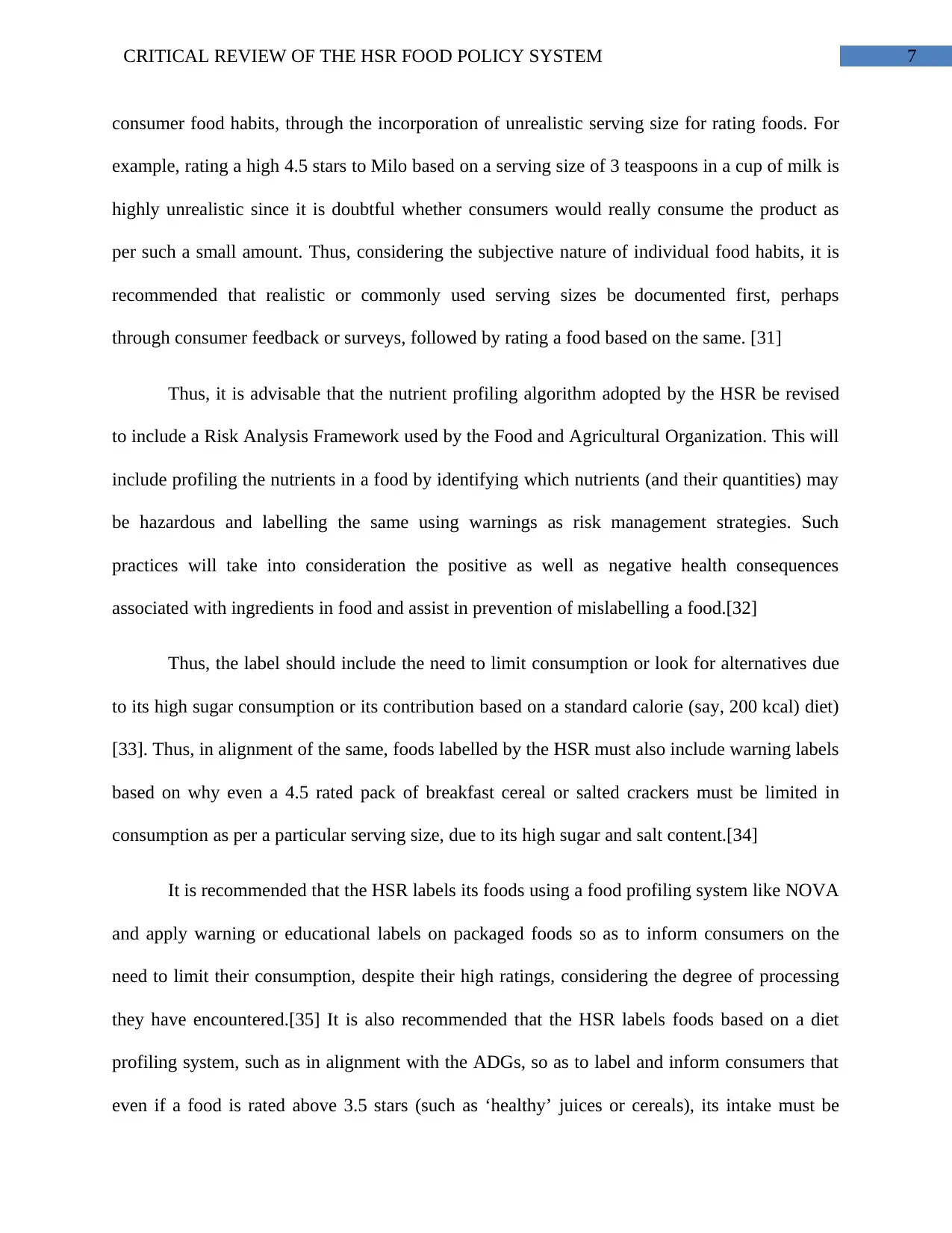
7CRITICAL REVIEW OF THE HSR FOOD POLICY SYSTEM
consumer food habits, through the incorporation of unrealistic serving size for rating foods. For
example, rating a high 4.5 stars to Milo based on a serving size of 3 teaspoons in a cup of milk is
highly unrealistic since it is doubtful whether consumers would really consume the product as
per such a small amount. Thus, considering the subjective nature of individual food habits, it is
recommended that realistic or commonly used serving sizes be documented first, perhaps
through consumer feedback or surveys, followed by rating a food based on the same. [31]
Thus, it is advisable that the nutrient profiling algorithm adopted by the HSR be revised
to include a Risk Analysis Framework used by the Food and Agricultural Organization. This will
include profiling the nutrients in a food by identifying which nutrients (and their quantities) may
be hazardous and labelling the same using warnings as risk management strategies. Such
practices will take into consideration the positive as well as negative health consequences
associated with ingredients in food and assist in prevention of mislabelling a food.[32]
Thus, the label should include the need to limit consumption or look for alternatives due
to its high sugar consumption or its contribution based on a standard calorie (say, 200 kcal) diet)
[33]. Thus, in alignment of the same, foods labelled by the HSR must also include warning labels
based on why even a 4.5 rated pack of breakfast cereal or salted crackers must be limited in
consumption as per a particular serving size, due to its high sugar and salt content.[34]
It is recommended that the HSR labels its foods using a food profiling system like NOVA
and apply warning or educational labels on packaged foods so as to inform consumers on the
need to limit their consumption, despite their high ratings, considering the degree of processing
they have encountered.[35] It is also recommended that the HSR labels foods based on a diet
profiling system, such as in alignment with the ADGs, so as to label and inform consumers that
even if a food is rated above 3.5 stars (such as ‘healthy’ juices or cereals), its intake must be
consumer food habits, through the incorporation of unrealistic serving size for rating foods. For
example, rating a high 4.5 stars to Milo based on a serving size of 3 teaspoons in a cup of milk is
highly unrealistic since it is doubtful whether consumers would really consume the product as
per such a small amount. Thus, considering the subjective nature of individual food habits, it is
recommended that realistic or commonly used serving sizes be documented first, perhaps
through consumer feedback or surveys, followed by rating a food based on the same. [31]
Thus, it is advisable that the nutrient profiling algorithm adopted by the HSR be revised
to include a Risk Analysis Framework used by the Food and Agricultural Organization. This will
include profiling the nutrients in a food by identifying which nutrients (and their quantities) may
be hazardous and labelling the same using warnings as risk management strategies. Such
practices will take into consideration the positive as well as negative health consequences
associated with ingredients in food and assist in prevention of mislabelling a food.[32]
Thus, the label should include the need to limit consumption or look for alternatives due
to its high sugar consumption or its contribution based on a standard calorie (say, 200 kcal) diet)
[33]. Thus, in alignment of the same, foods labelled by the HSR must also include warning labels
based on why even a 4.5 rated pack of breakfast cereal or salted crackers must be limited in
consumption as per a particular serving size, due to its high sugar and salt content.[34]
It is recommended that the HSR labels its foods using a food profiling system like NOVA
and apply warning or educational labels on packaged foods so as to inform consumers on the
need to limit their consumption, despite their high ratings, considering the degree of processing
they have encountered.[35] It is also recommended that the HSR labels foods based on a diet
profiling system, such as in alignment with the ADGs, so as to label and inform consumers that
even if a food is rated above 3.5 stars (such as ‘healthy’ juices or cereals), its intake must be
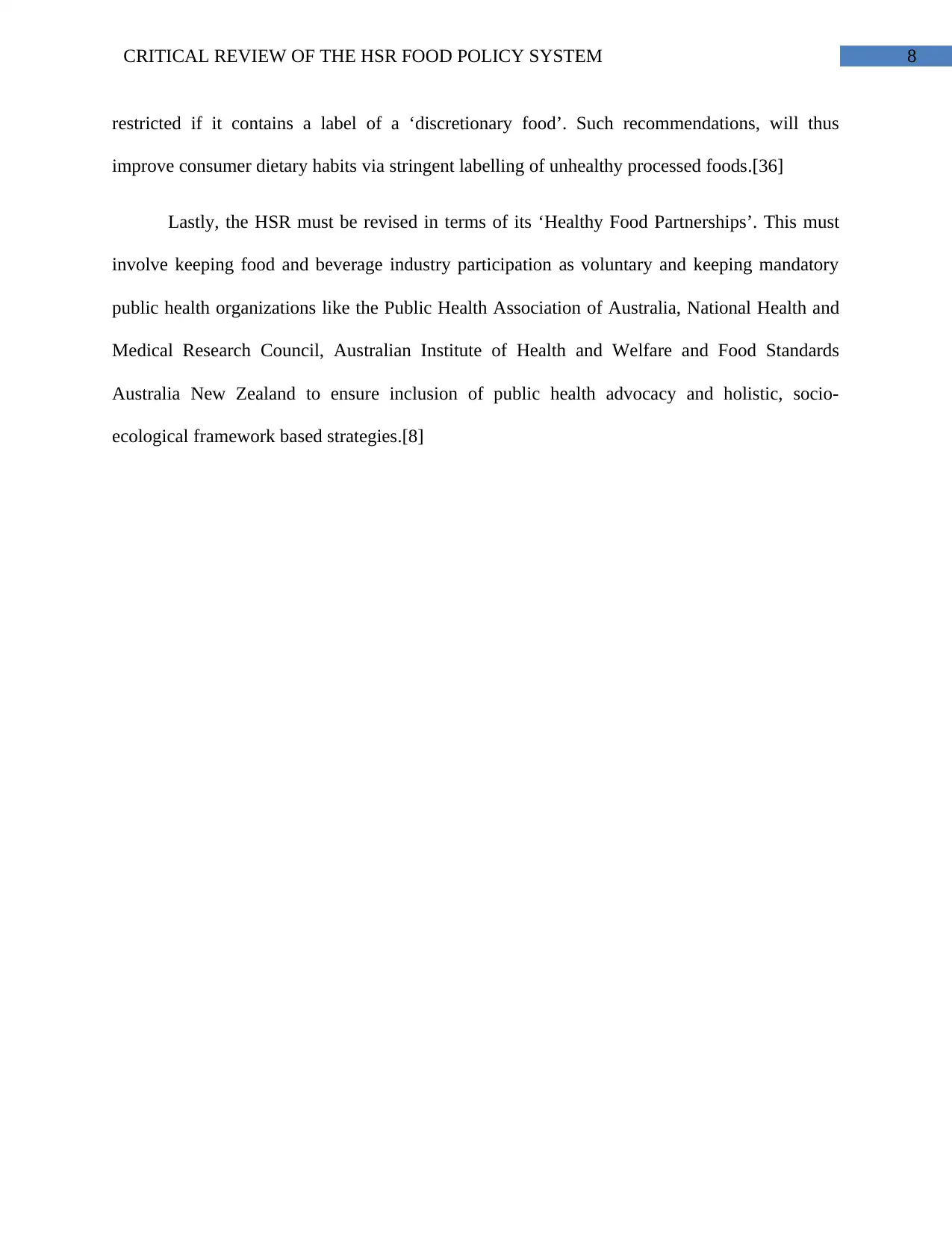
8CRITICAL REVIEW OF THE HSR FOOD POLICY SYSTEM
restricted if it contains a label of a ‘discretionary food’. Such recommendations, will thus
improve consumer dietary habits via stringent labelling of unhealthy processed foods.[36]
Lastly, the HSR must be revised in terms of its ‘Healthy Food Partnerships’. This must
involve keeping food and beverage industry participation as voluntary and keeping mandatory
public health organizations like the Public Health Association of Australia, National Health and
Medical Research Council, Australian Institute of Health and Welfare and Food Standards
Australia New Zealand to ensure inclusion of public health advocacy and holistic, socio-
ecological framework based strategies.[8]
restricted if it contains a label of a ‘discretionary food’. Such recommendations, will thus
improve consumer dietary habits via stringent labelling of unhealthy processed foods.[36]
Lastly, the HSR must be revised in terms of its ‘Healthy Food Partnerships’. This must
involve keeping food and beverage industry participation as voluntary and keeping mandatory
public health organizations like the Public Health Association of Australia, National Health and
Medical Research Council, Australian Institute of Health and Welfare and Food Standards
Australia New Zealand to ensure inclusion of public health advocacy and holistic, socio-
ecological framework based strategies.[8]
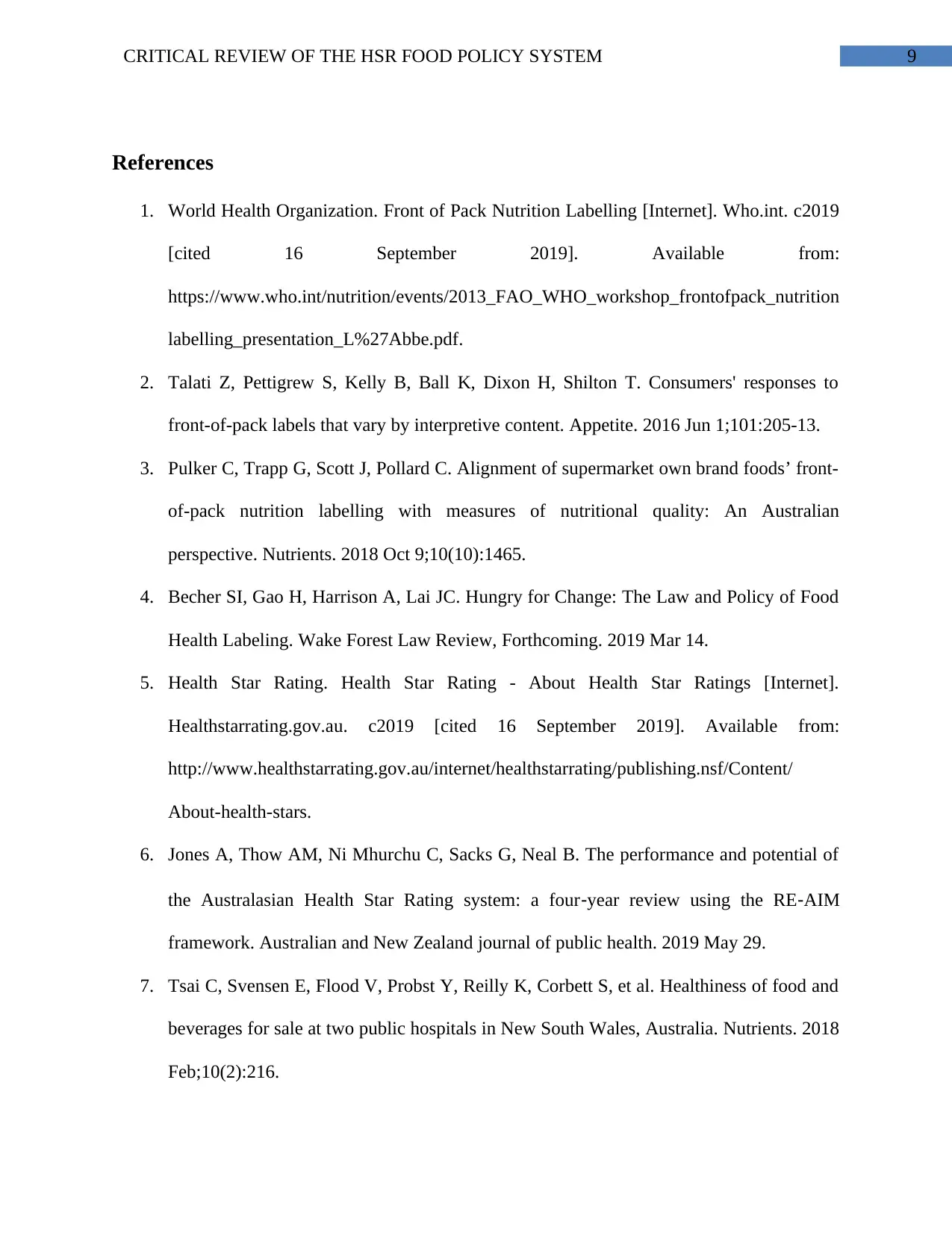
9CRITICAL REVIEW OF THE HSR FOOD POLICY SYSTEM
References
1. World Health Organization. Front of Pack Nutrition Labelling [Internet]. Who.int. c2019
[cited 16 September 2019]. Available from:
https://www.who.int/nutrition/events/2013_FAO_WHO_workshop_frontofpack_nutrition
labelling_presentation_L%27Abbe.pdf.
2. Talati Z, Pettigrew S, Kelly B, Ball K, Dixon H, Shilton T. Consumers' responses to
front-of-pack labels that vary by interpretive content. Appetite. 2016 Jun 1;101:205-13.
3. Pulker C, Trapp G, Scott J, Pollard C. Alignment of supermarket own brand foods’ front-
of-pack nutrition labelling with measures of nutritional quality: An Australian
perspective. Nutrients. 2018 Oct 9;10(10):1465.
4. Becher SI, Gao H, Harrison A, Lai JC. Hungry for Change: The Law and Policy of Food
Health Labeling. Wake Forest Law Review, Forthcoming. 2019 Mar 14.
5. Health Star Rating. Health Star Rating - About Health Star Ratings [Internet].
Healthstarrating.gov.au. c2019 [cited 16 September 2019]. Available from:
http://www.healthstarrating.gov.au/internet/healthstarrating/publishing.nsf/Content/
About-health-stars.
6. Jones A, Thow AM, Ni Mhurchu C, Sacks G, Neal B. The performance and potential of
the Australasian Health Star Rating system: a four‐year review using the RE‐AIM
framework. Australian and New Zealand journal of public health. 2019 May 29.
7. Tsai C, Svensen E, Flood V, Probst Y, Reilly K, Corbett S, et al. Healthiness of food and
beverages for sale at two public hospitals in New South Wales, Australia. Nutrients. 2018
Feb;10(2):216.
References
1. World Health Organization. Front of Pack Nutrition Labelling [Internet]. Who.int. c2019
[cited 16 September 2019]. Available from:
https://www.who.int/nutrition/events/2013_FAO_WHO_workshop_frontofpack_nutrition
labelling_presentation_L%27Abbe.pdf.
2. Talati Z, Pettigrew S, Kelly B, Ball K, Dixon H, Shilton T. Consumers' responses to
front-of-pack labels that vary by interpretive content. Appetite. 2016 Jun 1;101:205-13.
3. Pulker C, Trapp G, Scott J, Pollard C. Alignment of supermarket own brand foods’ front-
of-pack nutrition labelling with measures of nutritional quality: An Australian
perspective. Nutrients. 2018 Oct 9;10(10):1465.
4. Becher SI, Gao H, Harrison A, Lai JC. Hungry for Change: The Law and Policy of Food
Health Labeling. Wake Forest Law Review, Forthcoming. 2019 Mar 14.
5. Health Star Rating. Health Star Rating - About Health Star Ratings [Internet].
Healthstarrating.gov.au. c2019 [cited 16 September 2019]. Available from:
http://www.healthstarrating.gov.au/internet/healthstarrating/publishing.nsf/Content/
About-health-stars.
6. Jones A, Thow AM, Ni Mhurchu C, Sacks G, Neal B. The performance and potential of
the Australasian Health Star Rating system: a four‐year review using the RE‐AIM
framework. Australian and New Zealand journal of public health. 2019 May 29.
7. Tsai C, Svensen E, Flood V, Probst Y, Reilly K, Corbett S, et al. Healthiness of food and
beverages for sale at two public hospitals in New South Wales, Australia. Nutrients. 2018
Feb;10(2):216.
Secure Best Marks with AI Grader
Need help grading? Try our AI Grader for instant feedback on your assignments.
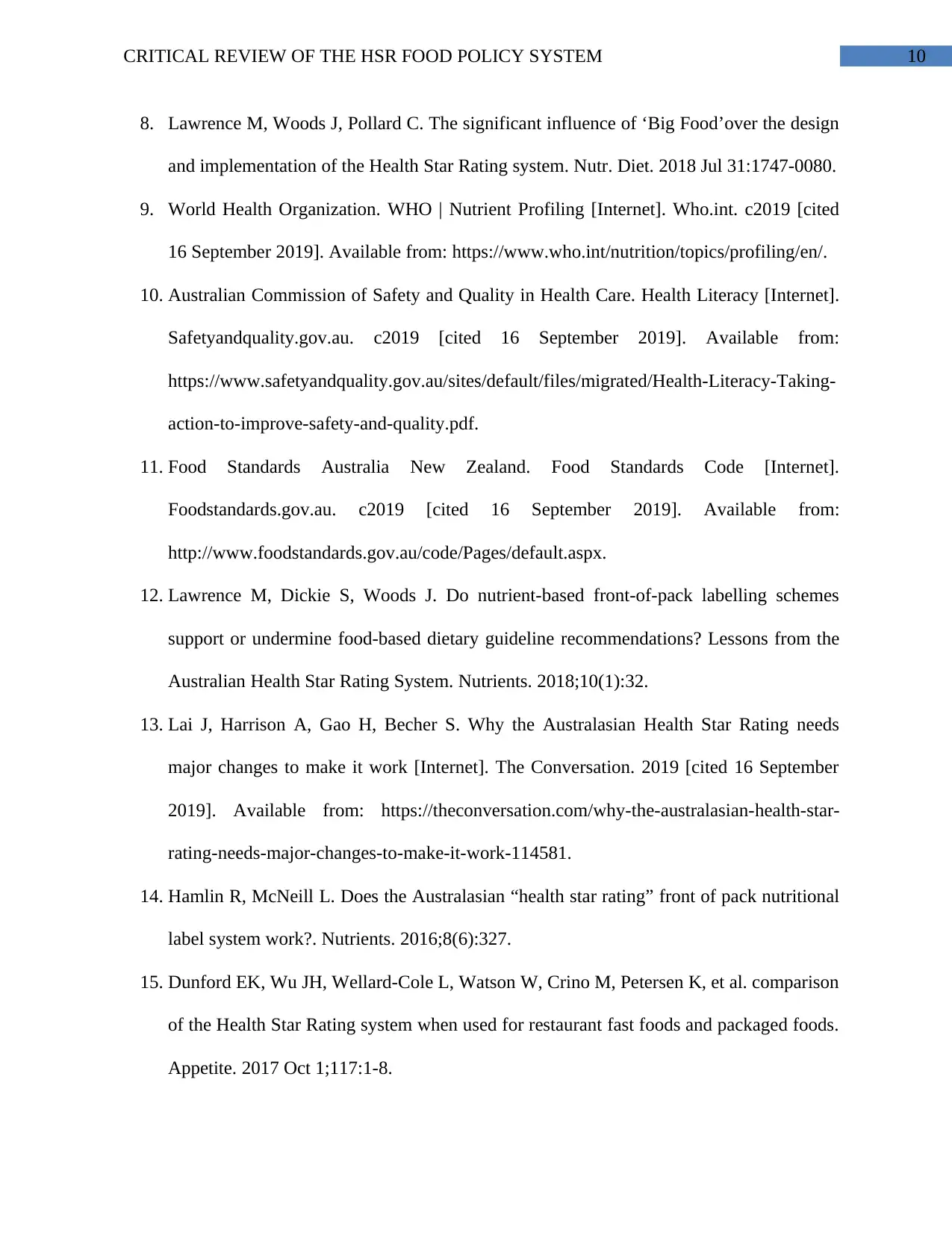
10CRITICAL REVIEW OF THE HSR FOOD POLICY SYSTEM
8. Lawrence M, Woods J, Pollard C. The significant influence of ‘Big Food’over the design
and implementation of the Health Star Rating system. Nutr. Diet. 2018 Jul 31:1747-0080.
9. World Health Organization. WHO | Nutrient Profiling [Internet]. Who.int. c2019 [cited
16 September 2019]. Available from: https://www.who.int/nutrition/topics/profiling/en/.
10. Australian Commission of Safety and Quality in Health Care. Health Literacy [Internet].
Safetyandquality.gov.au. c2019 [cited 16 September 2019]. Available from:
https://www.safetyandquality.gov.au/sites/default/files/migrated/Health-Literacy-Taking-
action-to-improve-safety-and-quality.pdf.
11. Food Standards Australia New Zealand. Food Standards Code [Internet].
Foodstandards.gov.au. c2019 [cited 16 September 2019]. Available from:
http://www.foodstandards.gov.au/code/Pages/default.aspx.
12. Lawrence M, Dickie S, Woods J. Do nutrient-based front-of-pack labelling schemes
support or undermine food-based dietary guideline recommendations? Lessons from the
Australian Health Star Rating System. Nutrients. 2018;10(1):32.
13. Lai J, Harrison A, Gao H, Becher S. Why the Australasian Health Star Rating needs
major changes to make it work [Internet]. The Conversation. 2019 [cited 16 September
2019]. Available from: https://theconversation.com/why-the-australasian-health-star-
rating-needs-major-changes-to-make-it-work-114581.
14. Hamlin R, McNeill L. Does the Australasian “health star rating” front of pack nutritional
label system work?. Nutrients. 2016;8(6):327.
15. Dunford EK, Wu JH, Wellard-Cole L, Watson W, Crino M, Petersen K, et al. comparison
of the Health Star Rating system when used for restaurant fast foods and packaged foods.
Appetite. 2017 Oct 1;117:1-8.
8. Lawrence M, Woods J, Pollard C. The significant influence of ‘Big Food’over the design
and implementation of the Health Star Rating system. Nutr. Diet. 2018 Jul 31:1747-0080.
9. World Health Organization. WHO | Nutrient Profiling [Internet]. Who.int. c2019 [cited
16 September 2019]. Available from: https://www.who.int/nutrition/topics/profiling/en/.
10. Australian Commission of Safety and Quality in Health Care. Health Literacy [Internet].
Safetyandquality.gov.au. c2019 [cited 16 September 2019]. Available from:
https://www.safetyandquality.gov.au/sites/default/files/migrated/Health-Literacy-Taking-
action-to-improve-safety-and-quality.pdf.
11. Food Standards Australia New Zealand. Food Standards Code [Internet].
Foodstandards.gov.au. c2019 [cited 16 September 2019]. Available from:
http://www.foodstandards.gov.au/code/Pages/default.aspx.
12. Lawrence M, Dickie S, Woods J. Do nutrient-based front-of-pack labelling schemes
support or undermine food-based dietary guideline recommendations? Lessons from the
Australian Health Star Rating System. Nutrients. 2018;10(1):32.
13. Lai J, Harrison A, Gao H, Becher S. Why the Australasian Health Star Rating needs
major changes to make it work [Internet]. The Conversation. 2019 [cited 16 September
2019]. Available from: https://theconversation.com/why-the-australasian-health-star-
rating-needs-major-changes-to-make-it-work-114581.
14. Hamlin R, McNeill L. Does the Australasian “health star rating” front of pack nutritional
label system work?. Nutrients. 2016;8(6):327.
15. Dunford EK, Wu JH, Wellard-Cole L, Watson W, Crino M, Petersen K, et al. comparison
of the Health Star Rating system when used for restaurant fast foods and packaged foods.
Appetite. 2017 Oct 1;117:1-8.
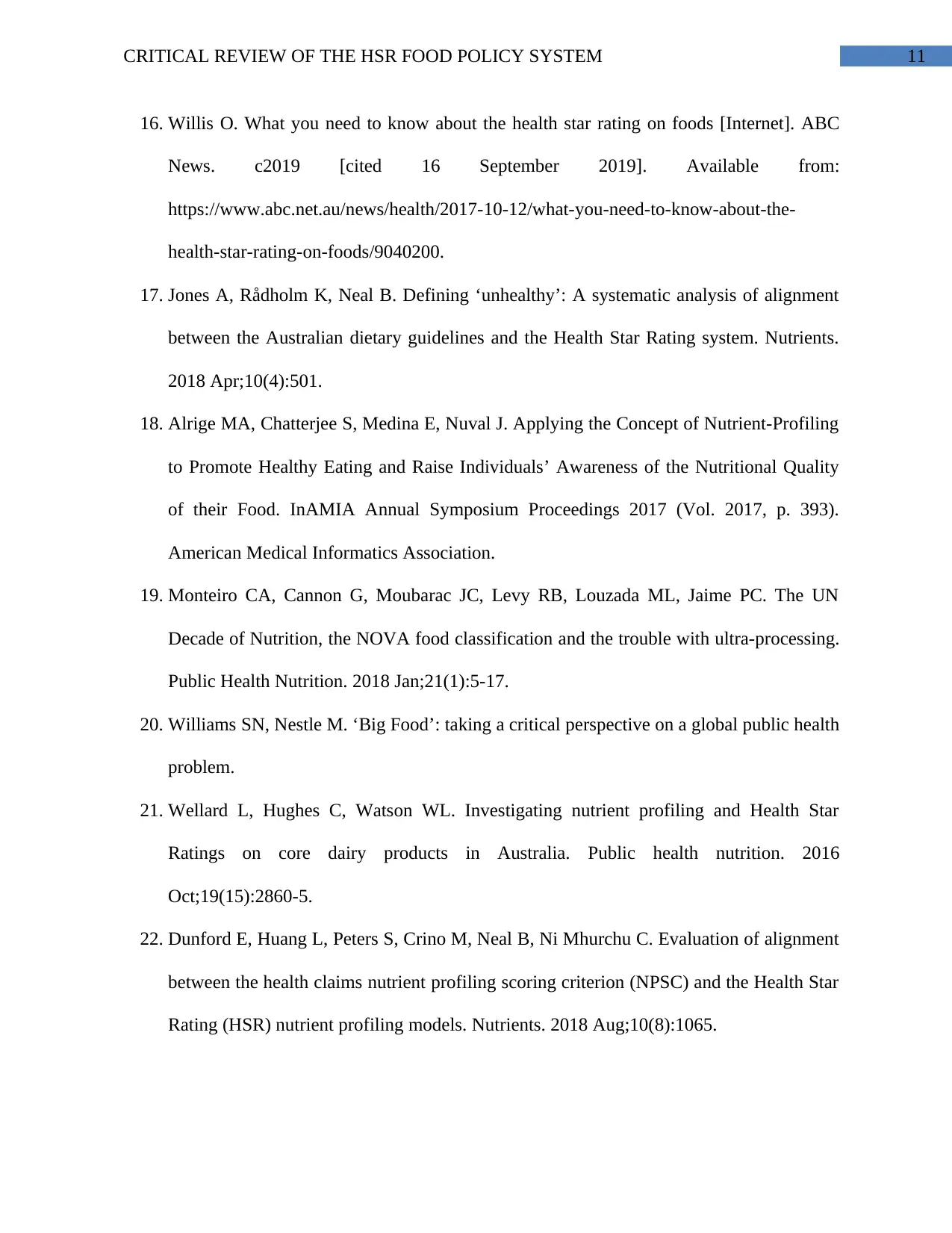
11CRITICAL REVIEW OF THE HSR FOOD POLICY SYSTEM
16. Willis O. What you need to know about the health star rating on foods [Internet]. ABC
News. c2019 [cited 16 September 2019]. Available from:
https://www.abc.net.au/news/health/2017-10-12/what-you-need-to-know-about-the-
health-star-rating-on-foods/9040200.
17. Jones A, Rådholm K, Neal B. Defining ‘unhealthy’: A systematic analysis of alignment
between the Australian dietary guidelines and the Health Star Rating system. Nutrients.
2018 Apr;10(4):501.
18. Alrige MA, Chatterjee S, Medina E, Nuval J. Applying the Concept of Nutrient-Profiling
to Promote Healthy Eating and Raise Individuals’ Awareness of the Nutritional Quality
of their Food. InAMIA Annual Symposium Proceedings 2017 (Vol. 2017, p. 393).
American Medical Informatics Association.
19. Monteiro CA, Cannon G, Moubarac JC, Levy RB, Louzada ML, Jaime PC. The UN
Decade of Nutrition, the NOVA food classification and the trouble with ultra-processing.
Public Health Nutrition. 2018 Jan;21(1):5-17.
20. Williams SN, Nestle M. ‘Big Food’: taking a critical perspective on a global public health
problem.
21. Wellard L, Hughes C, Watson WL. Investigating nutrient profiling and Health Star
Ratings on core dairy products in Australia. Public health nutrition. 2016
Oct;19(15):2860-5.
22. Dunford E, Huang L, Peters S, Crino M, Neal B, Ni Mhurchu C. Evaluation of alignment
between the health claims nutrient profiling scoring criterion (NPSC) and the Health Star
Rating (HSR) nutrient profiling models. Nutrients. 2018 Aug;10(8):1065.
16. Willis O. What you need to know about the health star rating on foods [Internet]. ABC
News. c2019 [cited 16 September 2019]. Available from:
https://www.abc.net.au/news/health/2017-10-12/what-you-need-to-know-about-the-
health-star-rating-on-foods/9040200.
17. Jones A, Rådholm K, Neal B. Defining ‘unhealthy’: A systematic analysis of alignment
between the Australian dietary guidelines and the Health Star Rating system. Nutrients.
2018 Apr;10(4):501.
18. Alrige MA, Chatterjee S, Medina E, Nuval J. Applying the Concept of Nutrient-Profiling
to Promote Healthy Eating and Raise Individuals’ Awareness of the Nutritional Quality
of their Food. InAMIA Annual Symposium Proceedings 2017 (Vol. 2017, p. 393).
American Medical Informatics Association.
19. Monteiro CA, Cannon G, Moubarac JC, Levy RB, Louzada ML, Jaime PC. The UN
Decade of Nutrition, the NOVA food classification and the trouble with ultra-processing.
Public Health Nutrition. 2018 Jan;21(1):5-17.
20. Williams SN, Nestle M. ‘Big Food’: taking a critical perspective on a global public health
problem.
21. Wellard L, Hughes C, Watson WL. Investigating nutrient profiling and Health Star
Ratings on core dairy products in Australia. Public health nutrition. 2016
Oct;19(15):2860-5.
22. Dunford E, Huang L, Peters S, Crino M, Neal B, Ni Mhurchu C. Evaluation of alignment
between the health claims nutrient profiling scoring criterion (NPSC) and the Health Star
Rating (HSR) nutrient profiling models. Nutrients. 2018 Aug;10(8):1065.
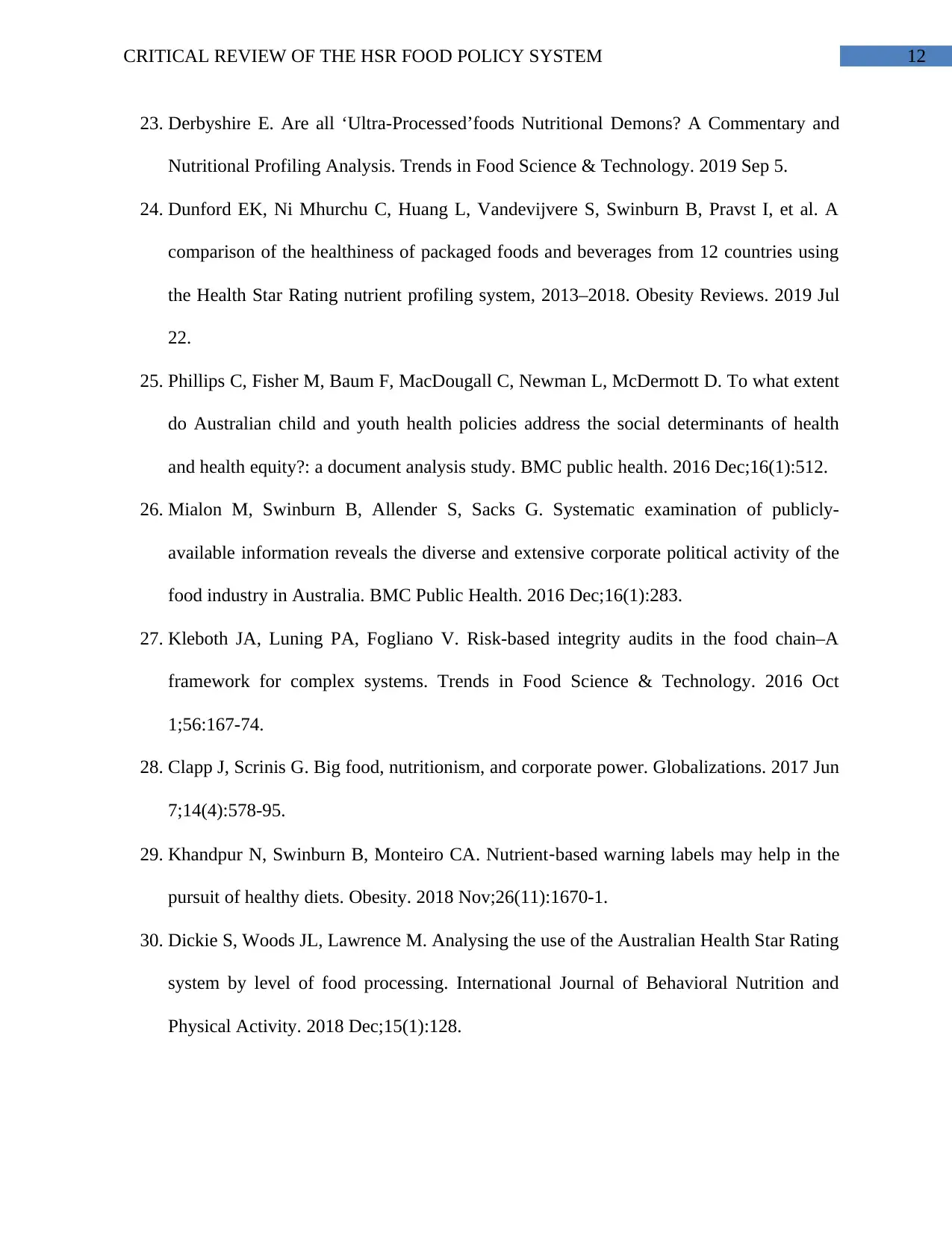
12CRITICAL REVIEW OF THE HSR FOOD POLICY SYSTEM
23. Derbyshire E. Are all ‘Ultra-Processed’foods Nutritional Demons? A Commentary and
Nutritional Profiling Analysis. Trends in Food Science & Technology. 2019 Sep 5.
24. Dunford EK, Ni Mhurchu C, Huang L, Vandevijvere S, Swinburn B, Pravst I, et al. A
comparison of the healthiness of packaged foods and beverages from 12 countries using
the Health Star Rating nutrient profiling system, 2013–2018. Obesity Reviews. 2019 Jul
22.
25. Phillips C, Fisher M, Baum F, MacDougall C, Newman L, McDermott D. To what extent
do Australian child and youth health policies address the social determinants of health
and health equity?: a document analysis study. BMC public health. 2016 Dec;16(1):512.
26. Mialon M, Swinburn B, Allender S, Sacks G. Systematic examination of publicly-
available information reveals the diverse and extensive corporate political activity of the
food industry in Australia. BMC Public Health. 2016 Dec;16(1):283.
27. Kleboth JA, Luning PA, Fogliano V. Risk-based integrity audits in the food chain–A
framework for complex systems. Trends in Food Science & Technology. 2016 Oct
1;56:167-74.
28. Clapp J, Scrinis G. Big food, nutritionism, and corporate power. Globalizations. 2017 Jun
7;14(4):578-95.
29. Khandpur N, Swinburn B, Monteiro CA. Nutrient‐based warning labels may help in the
pursuit of healthy diets. Obesity. 2018 Nov;26(11):1670-1.
30. Dickie S, Woods JL, Lawrence M. Analysing the use of the Australian Health Star Rating
system by level of food processing. International Journal of Behavioral Nutrition and
Physical Activity. 2018 Dec;15(1):128.
23. Derbyshire E. Are all ‘Ultra-Processed’foods Nutritional Demons? A Commentary and
Nutritional Profiling Analysis. Trends in Food Science & Technology. 2019 Sep 5.
24. Dunford EK, Ni Mhurchu C, Huang L, Vandevijvere S, Swinburn B, Pravst I, et al. A
comparison of the healthiness of packaged foods and beverages from 12 countries using
the Health Star Rating nutrient profiling system, 2013–2018. Obesity Reviews. 2019 Jul
22.
25. Phillips C, Fisher M, Baum F, MacDougall C, Newman L, McDermott D. To what extent
do Australian child and youth health policies address the social determinants of health
and health equity?: a document analysis study. BMC public health. 2016 Dec;16(1):512.
26. Mialon M, Swinburn B, Allender S, Sacks G. Systematic examination of publicly-
available information reveals the diverse and extensive corporate political activity of the
food industry in Australia. BMC Public Health. 2016 Dec;16(1):283.
27. Kleboth JA, Luning PA, Fogliano V. Risk-based integrity audits in the food chain–A
framework for complex systems. Trends in Food Science & Technology. 2016 Oct
1;56:167-74.
28. Clapp J, Scrinis G. Big food, nutritionism, and corporate power. Globalizations. 2017 Jun
7;14(4):578-95.
29. Khandpur N, Swinburn B, Monteiro CA. Nutrient‐based warning labels may help in the
pursuit of healthy diets. Obesity. 2018 Nov;26(11):1670-1.
30. Dickie S, Woods JL, Lawrence M. Analysing the use of the Australian Health Star Rating
system by level of food processing. International Journal of Behavioral Nutrition and
Physical Activity. 2018 Dec;15(1):128.
Paraphrase This Document
Need a fresh take? Get an instant paraphrase of this document with our AI Paraphraser
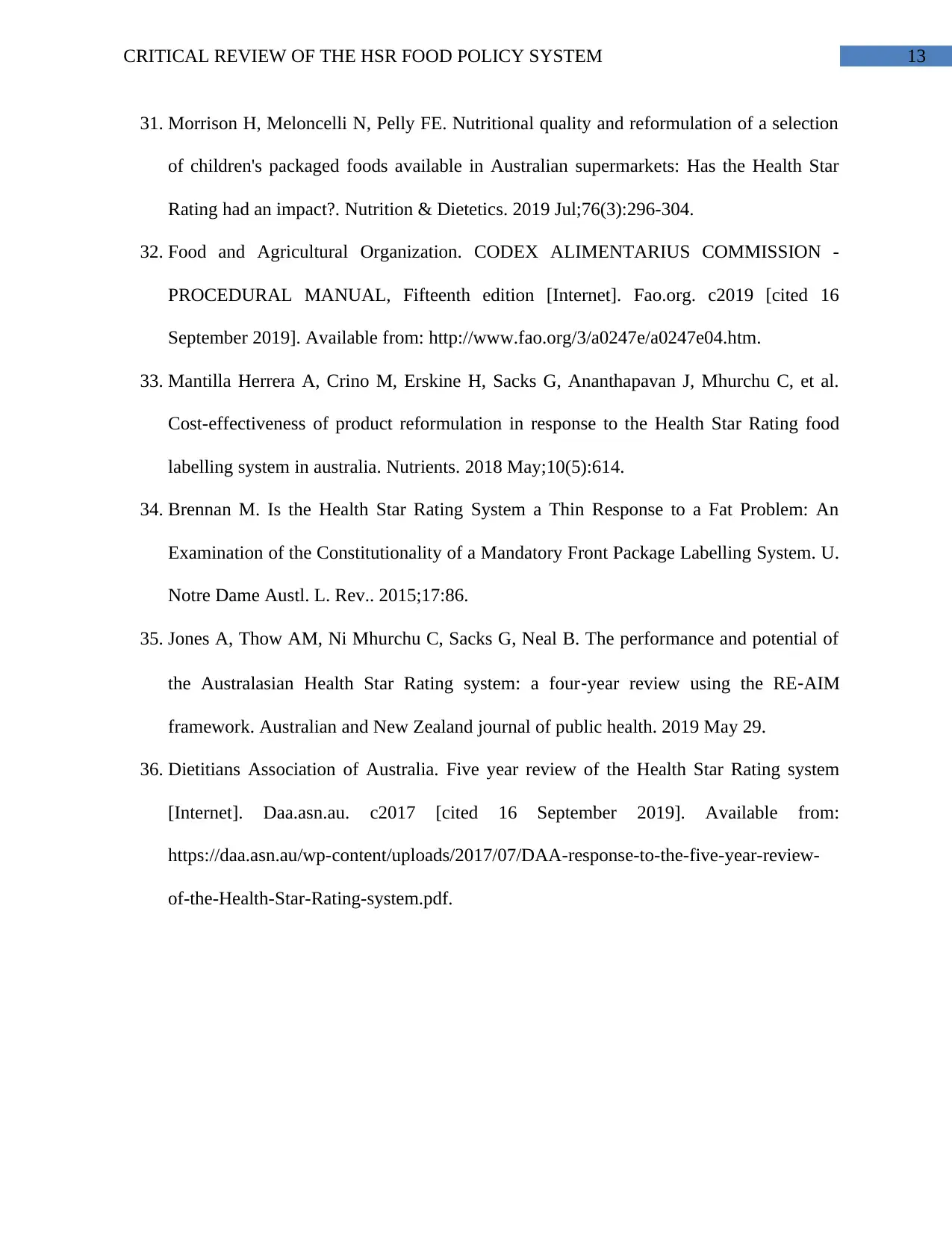
13CRITICAL REVIEW OF THE HSR FOOD POLICY SYSTEM
31. Morrison H, Meloncelli N, Pelly FE. Nutritional quality and reformulation of a selection
of children's packaged foods available in Australian supermarkets: Has the Health Star
Rating had an impact?. Nutrition & Dietetics. 2019 Jul;76(3):296-304.
32. Food and Agricultural Organization. CODEX ALIMENTARIUS COMMISSION -
PROCEDURAL MANUAL, Fifteenth edition [Internet]. Fao.org. c2019 [cited 16
September 2019]. Available from: http://www.fao.org/3/a0247e/a0247e04.htm.
33. Mantilla Herrera A, Crino M, Erskine H, Sacks G, Ananthapavan J, Mhurchu C, et al.
Cost-effectiveness of product reformulation in response to the Health Star Rating food
labelling system in australia. Nutrients. 2018 May;10(5):614.
34. Brennan M. Is the Health Star Rating System a Thin Response to a Fat Problem: An
Examination of the Constitutionality of a Mandatory Front Package Labelling System. U.
Notre Dame Austl. L. Rev.. 2015;17:86.
35. Jones A, Thow AM, Ni Mhurchu C, Sacks G, Neal B. The performance and potential of
the Australasian Health Star Rating system: a four‐year review using the RE‐AIM
framework. Australian and New Zealand journal of public health. 2019 May 29.
36. Dietitians Association of Australia. Five year review of the Health Star Rating system
[Internet]. Daa.asn.au. c2017 [cited 16 September 2019]. Available from:
https://daa.asn.au/wp-content/uploads/2017/07/DAA-response-to-the-five-year-review-
of-the-Health-Star-Rating-system.pdf.
31. Morrison H, Meloncelli N, Pelly FE. Nutritional quality and reformulation of a selection
of children's packaged foods available in Australian supermarkets: Has the Health Star
Rating had an impact?. Nutrition & Dietetics. 2019 Jul;76(3):296-304.
32. Food and Agricultural Organization. CODEX ALIMENTARIUS COMMISSION -
PROCEDURAL MANUAL, Fifteenth edition [Internet]. Fao.org. c2019 [cited 16
September 2019]. Available from: http://www.fao.org/3/a0247e/a0247e04.htm.
33. Mantilla Herrera A, Crino M, Erskine H, Sacks G, Ananthapavan J, Mhurchu C, et al.
Cost-effectiveness of product reformulation in response to the Health Star Rating food
labelling system in australia. Nutrients. 2018 May;10(5):614.
34. Brennan M. Is the Health Star Rating System a Thin Response to a Fat Problem: An
Examination of the Constitutionality of a Mandatory Front Package Labelling System. U.
Notre Dame Austl. L. Rev.. 2015;17:86.
35. Jones A, Thow AM, Ni Mhurchu C, Sacks G, Neal B. The performance and potential of
the Australasian Health Star Rating system: a four‐year review using the RE‐AIM
framework. Australian and New Zealand journal of public health. 2019 May 29.
36. Dietitians Association of Australia. Five year review of the Health Star Rating system
[Internet]. Daa.asn.au. c2017 [cited 16 September 2019]. Available from:
https://daa.asn.au/wp-content/uploads/2017/07/DAA-response-to-the-five-year-review-
of-the-Health-Star-Rating-system.pdf.
1 out of 14
Related Documents
Your All-in-One AI-Powered Toolkit for Academic Success.
+13062052269
info@desklib.com
Available 24*7 on WhatsApp / Email
![[object Object]](/_next/static/media/star-bottom.7253800d.svg)
Unlock your academic potential
© 2024 | Zucol Services PVT LTD | All rights reserved.




